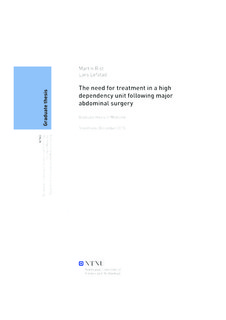The need for treatment in a high dependency unit following major abdominal surgery
Master thesis
Permanent lenke
http://hdl.handle.net/11250/2417763Utgivelsesdato
2015Metadata
Vis full innførselSamlinger
Sammendrag
Introduction: Patients undergoing major surgical procedures, such as gastrointestinal cancer surgery, are considered to be at high risk for postoperative complications. Therefore, these patients are routinely monitored in a controlled environment in the early postoperative period, commonly known as a post-anesthesia care unit” (PACU) or “high dependency unit” (HDU). However, admittance to an HDU is expensive and inappropriate use may reduce the capacity for other surgical procedures. Therefore, identifying which patients are in need of a prolonged length of stay (LOS) in an HDU is important. Our goal was to describe the physiological course and need for HDU-specific interventions during the first 24 hours of the postoperative period in patients undergoing major abdominal surgery with an open technique. Materials and methods: Adult patients undergoing open abdominal surgery between August and November 2015 at St. Olav University hospital (Trondheim, Norway), scheduled to be observed in a high dependency unit (HDU) until the first postoperative day, were consecutively included. HDU-specific interventions were defined as a need for respiratory support, vasoactive medications, fluid replacement therapy > 500 mL/h, or a need for high dose opioids (morphine equivalents > 7.5mg/h i.v.). Data was collected from patient medical records and from the applied anesthesia information management system (AIMS). The Cox proportional hazard model was applied to assess the effects of relevant co-variates on the duration of vasopressor infusion. Results: Fifty-one patients were included in the study between August and November 2015. About one third of the patients were in need of HDU-specific interventions after the first six postoperative hours, while most of the patients required HDU-specific interventions before this time. The most prevalent intervention was an infusion of norepinephrine. Intraoperative blood loss > 750 mL and increasing age were significantly associated with the time to discontinuation of norepinephrine after surgery. Conclusion: Our study demonstrates that there is a large variation in the need for HDUspecific treatment after major elective abdominal surgery, especially after the first six hours of the postoperative period. Further development of prediction models is warranted to help assess the need for HDU interventions in patients undergoing major surgery.
